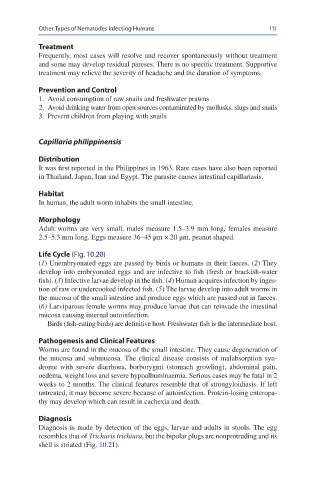Page 118 - Medical Parasitology_ A Textbook ( PDFDrive )
P. 118
Other Types of Nematodes Infecting Humans 111
Treatment
Frequently, most cases will resolve and recover spontaneously without treatment
and some may develop residual pareses. There is no specific treatment. Supportive
treatment may relieve the severity of headache and the duration of symptoms.
Prevention and Control
1. Avoid consumption of raw snails and freshwater prawns
2. Avoid drinking water from open sources contaminated by mollusks, slugs and snails
3. Prevent children from playing with snails
Capillaria philippinensis
Distribution
It was first reported in the Philippines in 1963. Rare cases have also been reported
in Thailand, Japan, Iran and Egypt. The parasite causes intestinal capillariasis.
Habitat
In human, the adult worm inhabits the small intestine.
Morphology
Adult worms are very small, males measure 1.5–3.9 mm long, females measure
2.5–5.3 mm long. Eggs measure 36–45 μm × 20 μm, peanut shaped.
Life Cycle (Fig. 10.20)
(1) Unembryonated eggs are passed by birds or humans in their faeces. (2) They
develop into embryonated eggs and are infective to fish (fresh or brackish-water
fish). (3) Infective larvae develop in the fish. (4) Human acquires infection by inges-
tion of raw or undercooked infected fish. (5) The larvae develop into adult worms in
the mucosa of the small intestine and produce eggs which are passed out in faeces.
(6) Larviparous female worms may produce larvae that can reinvade the intestinal
mucosa causing internal autoinfection.
Birds (fish-eating birds) are definitive host. Freshwater fish is the intermediate host.
Pathogenesis and Clinical Features
Worms are found in the mucosa of the small intestine. They cause degeneration of
the mucosa and submucosa. The clinical disease consists of malabsorption syn-
drome with severe diarrhoea, borborygmi (stomach growling), abdominal pain,
oedema, weight loss and severe hypoalbuminaemia. Serious cases may be fatal in 2
weeks to 2 months. The clinical features resemble that of strongyloidiasis. If left
untreated, it may become severe because of autoinfection. Protein-losing enteropa-
thy may develop which can result in cachexia and death.
Diagnosis
Diagnosis is made by detection of the eggs, larvae and adults in stools. The egg
resembles that of Trichuris trichiura, but the bipolar plugs are nonprotruding and its
shell is striated (Fig. 10.21).

